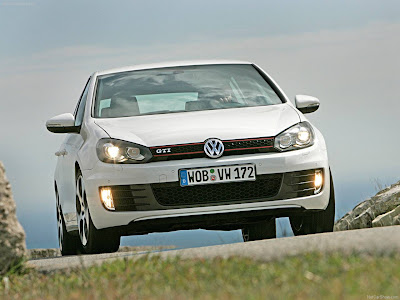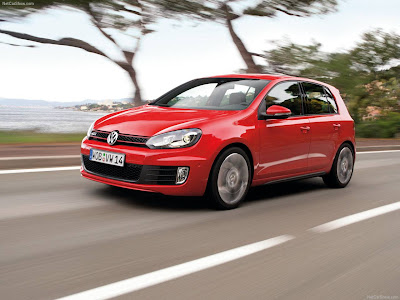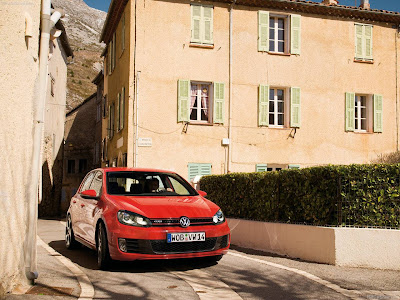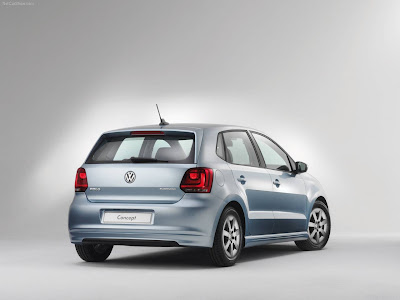








After the Polo, the BlueMotion offensive and the Golf GTI, Volkswagen is throwing the arrow next to your quiver: the Volkswagen Golf GTD. It is extremely fuel efficient yet very sporty, and is debuting as a world premiere at the Auto Mobil International 2009 in Leipzig (March 28-April 05). GTD code letters carried on a tradition: the VW Golf GTD first appeared in 1982 - was the GTI from diesel engines. Now, Volkswagen has perfected the various aspects of sportsmanship. The new Golf GTD with its 125 kW / 170 PS is addressed to all fans that diesel in a maximum dynamic performance. This is where GTD shows a clear affinity with the new GTI (155 kW / 210 PS). While the GTI is in a league of its own with an efficient turbo petrol engine that offers the same performance as more expensive sports cars, the Volkswagen Golf GTD is making its appearance with great fuel economy. Every 100 miles, only 5.3 liters of fuel to flow through the valves of the piezo-injection common rail engine that can not be set as a diesel. Which is equivalent to CO2 emissions of just 139 g / km. This contrasts with a maximum speed of 222 km / h and 8.1 seconds for the sprint to 100 km / h.
Range of about 1000 kilometers
Like the GTI, GTD is a 6-speed manual transmission can be changed by an optional 6-speed DSG - which in the eyes of many experts is the most efficient machines of our time. The Volkswagen Golf GTD with DSG reaches a top speed of 220 km / h, accelerates to 100 km / h in 8.1 seconds and consumes 5.6 liters of diesel on average (147 g / km CO2). These low fuel consumption while taking GTD variants at distances of about 1000 kilometers on one tank of fuel (55 liters).
The GTD sport chassis equipped with standard 17-inch alloy wheels ( "Seattle" type) has a close relationship with the GTI, very agile in its handling properties, as well as its parallel in the appearance and characteristics.
VW Golf GTD foreign
The exterior shows clearly that this is the sporty VW Golf with a diesel engine. Take the lead, for example: bumpers, radiator grille and headlights are a 1:1 match with the GTI. However, the horizontal stripes of red on the radiator grille in chrome are called in GTD. At the rear, the modified turbo-diesel sports a diffuser. GTD but does not come with the emblem of the purchase of the car, the diesel version of the Golf can be recognized by its twin chrome exhausts on the left side of the diffuser (the GTI has a tube on the left and one on the right) .
VW Golf GTD sound
Sound - sound sports - has not traditionally been a strength of diesel engines. However, the GTD of new common rail engine is different. Since it no longer has an overlapping "hammering" sound that was once characteristic of diesel engines, the engineers were able to adjust their sound for the first time. This is achieved through a sound generator, giving a beep, especially in the lower range of engine speed. The sound generator electromagnetic evaluates engine speed, the momentary power demand and vehicle speed and the data obtained through the CAN bus of the car and the engine sound you hear music on the inside.
VW Golf GTD interior
Volkswagen GT philosophy is also reflected in the interior. It is expressed in the standard high-end sports seats, a 3-spoke leather steering wheel, whose curvature is flattened at the bottom (in the GTD signature chrome badge), leather parking brake lever and leather gearshift with sewing start contrasting color. However, unlike the GTI in the red, but it is not gray. The same applies to seats in sports "Jacky" Pattern: The color chosen for the flat felled seams are an elegant gray (gray Arts ") instead of red (" Red Flash "). The seats themselves are called a "Black-White" color.
VW Golf GTD safety and comfort
Other standard features of the Volkswagen Golf GTD include details such as black roofline and a black roof pillar trim, special interior accents, seven airbags including knee airbag on the driver's side, automatic climate control (Climatronic), front fog lights with the production of chrome, daytime running lights, ESP, a winter package (with heated windshield washer nozzles, heated front seats, headlamp cleaning system indicator light and low washer fluid) and the radio system 210 CCD. However, the most important component of the standard VW Golf GTD team remains the "common rail TDI with 170 hp that are used in golf for the first time.
TDI technology in detail
The engine displacement of 1968 cm3 is a new generation of TDI. Gives its maximum power at 4,200 rpm. The engine - the sport as it is fuel efficient - develops 350 Newton-meters of torque between 1750 and 2500 rpm. Its specific torque is 177.8 Newton-meters per liter of engine displacement. The result is that in virtually any driving situation, the sixteen-valve four-cylinder engine provides power equivalent to a six-cylinder engine sports car.
About the technology: the induction of fuel is in the hands of a rail system. Fuel injection pressures up to 1800 bar and a special eight-hole injection nozzles achieve exceptionally fine spray of diesel fuel. The eight-hole injection nozzles are driven by what is known as piezo injectors online. In this process, electrical piezoelectric crystals - powered by hydraulics - begin injection in fractions of a second. Compared to conventional solenoid valves, piezo technology enables more flexible injection processes and more accurately measure smaller amounts of fuel. The results are very quiet and pleasantly smooth engine performance, exceptionally fast response and excellent fuel economy and emissions values already mentioned.
Another of the characteristics which have a positive effect on the acoustics of the car is maintenance free for the toothed belt camshaft. Conversion to common rail technology and many other acoustic measures such as a noise buffer film on the windshield, the new Golf GTD one of the quietest diesel models in its class. Furthermore, the GTD will comply with the emission standard Euro-5. Advance sales of the Volkswagen Golf GTD will begin in Germany in early May 2009. And the prospects for successful market launch looks good. Because this sporty Volkswagen fits perfectly with our time.
Range of about 1000 kilometers
Like the GTI, GTD is a 6-speed manual transmission can be changed by an optional 6-speed DSG - which in the eyes of many experts is the most efficient machines of our time. The Volkswagen Golf GTD with DSG reaches a top speed of 220 km / h, accelerates to 100 km / h in 8.1 seconds and consumes 5.6 liters of diesel on average (147 g / km CO2). These low fuel consumption while taking GTD variants at distances of about 1000 kilometers on one tank of fuel (55 liters).
The GTD sport chassis equipped with standard 17-inch alloy wheels ( "Seattle" type) has a close relationship with the GTI, very agile in its handling properties, as well as its parallel in the appearance and characteristics.
VW Golf GTD foreign
The exterior shows clearly that this is the sporty VW Golf with a diesel engine. Take the lead, for example: bumpers, radiator grille and headlights are a 1:1 match with the GTI. However, the horizontal stripes of red on the radiator grille in chrome are called in GTD. At the rear, the modified turbo-diesel sports a diffuser. GTD but does not come with the emblem of the purchase of the car, the diesel version of the Golf can be recognized by its twin chrome exhausts on the left side of the diffuser (the GTI has a tube on the left and one on the right) .
VW Golf GTD sound
Sound - sound sports - has not traditionally been a strength of diesel engines. However, the GTD of new common rail engine is different. Since it no longer has an overlapping "hammering" sound that was once characteristic of diesel engines, the engineers were able to adjust their sound for the first time. This is achieved through a sound generator, giving a beep, especially in the lower range of engine speed. The sound generator electromagnetic evaluates engine speed, the momentary power demand and vehicle speed and the data obtained through the CAN bus of the car and the engine sound you hear music on the inside.
VW Golf GTD interior
Volkswagen GT philosophy is also reflected in the interior. It is expressed in the standard high-end sports seats, a 3-spoke leather steering wheel, whose curvature is flattened at the bottom (in the GTD signature chrome badge), leather parking brake lever and leather gearshift with sewing start contrasting color. However, unlike the GTI in the red, but it is not gray. The same applies to seats in sports "Jacky" Pattern: The color chosen for the flat felled seams are an elegant gray (gray Arts ") instead of red (" Red Flash "). The seats themselves are called a "Black-White" color.
VW Golf GTD safety and comfort
Other standard features of the Volkswagen Golf GTD include details such as black roofline and a black roof pillar trim, special interior accents, seven airbags including knee airbag on the driver's side, automatic climate control (Climatronic), front fog lights with the production of chrome, daytime running lights, ESP, a winter package (with heated windshield washer nozzles, heated front seats, headlamp cleaning system indicator light and low washer fluid) and the radio system 210 CCD. However, the most important component of the standard VW Golf GTD team remains the "common rail TDI with 170 hp that are used in golf for the first time.
TDI technology in detail
The engine displacement of 1968 cm3 is a new generation of TDI. Gives its maximum power at 4,200 rpm. The engine - the sport as it is fuel efficient - develops 350 Newton-meters of torque between 1750 and 2500 rpm. Its specific torque is 177.8 Newton-meters per liter of engine displacement. The result is that in virtually any driving situation, the sixteen-valve four-cylinder engine provides power equivalent to a six-cylinder engine sports car.
About the technology: the induction of fuel is in the hands of a rail system. Fuel injection pressures up to 1800 bar and a special eight-hole injection nozzles achieve exceptionally fine spray of diesel fuel. The eight-hole injection nozzles are driven by what is known as piezo injectors online. In this process, electrical piezoelectric crystals - powered by hydraulics - begin injection in fractions of a second. Compared to conventional solenoid valves, piezo technology enables more flexible injection processes and more accurately measure smaller amounts of fuel. The results are very quiet and pleasantly smooth engine performance, exceptionally fast response and excellent fuel economy and emissions values already mentioned.
Another of the characteristics which have a positive effect on the acoustics of the car is maintenance free for the toothed belt camshaft. Conversion to common rail technology and many other acoustic measures such as a noise buffer film on the windshield, the new Golf GTD one of the quietest diesel models in its class. Furthermore, the GTD will comply with the emission standard Euro-5. Advance sales of the Volkswagen Golf GTD will begin in Germany in early May 2009. And the prospects for successful market launch looks good. Because this sporty Volkswagen fits perfectly with our time.































